
The Louvre, or the Louvre Museum, is a national art museum in Paris, France, and one of the most famous museums in the world. It is located on the Right Bank of the Seine in the city's 1st arrondissement and home to some of the most canonical works of Western art, including the Mona Lisa,Venus de Milo, and Winged Victory. The museum is housed in the Louvre Palace, originally built in the late 12th to 13th century under Philip II. Remnants of the Medieval Louvre fortress are visible in the basement of the museum. Due to urban expansion, the fortress eventually lost its defensive function, and in 1546 Francis I converted it into the primary residence of the French kings.

The Musée d'Orsay is a museum in Paris, France, on the Left Bank of the Seine. It is housed in the former Gare d'Orsay, a Beaux-Arts railway station built between 1898 and 1900. The museum holds mainly French art dating from 1848 to 1914, including paintings, sculptures, furniture, and photography. It houses the largest collection of Impressionist and post-Impressionist masterpieces in the world, by painters including Berthe Morisot, Claude Monet, Édouard Manet, Degas, Renoir, Cézanne, Seurat, Sisley, Gauguin, and van Gogh. Many of these works were held at the Galerie nationale du Jeu de Paume prior to the museum's opening in 1986. It is one of the largest art museums in Europe.

Ferdinand Victor Eugène Delacroix was a French Romantic artist who was regarded as the leader of the French Romantic school.
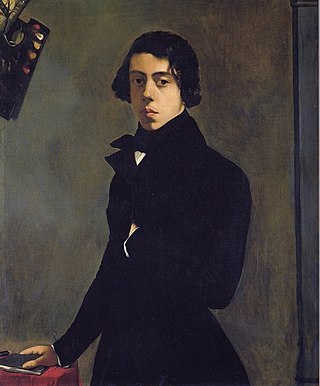
Théodore Chassériau was a Dominican-born French Romantic painter noted for his portraits, historical and religious paintings, allegorical murals, and Orientalist images inspired by his travels to Algeria. Early in his career he painted in a Neoclassical style close to that of his teacher Jean-Auguste-Dominique Ingres, but in his later works he was strongly influenced by the Romantic style of Eugène Delacroix. He was a prolific draftsman, and made a suite of prints to illustrate Shakespeare's Othello. The portrait he painted at the age of 15 of Prosper Marilhat makes Chassériau the youngest painter exhibited at the Louvre museum.
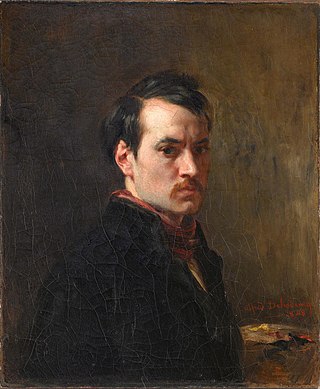
Alfred Dehodencq was a French Orientalist painter known for his vivid oil paintings of Andalusian and North African scenes.

Paul-Marc-Joseph Chenavard was a French painter.
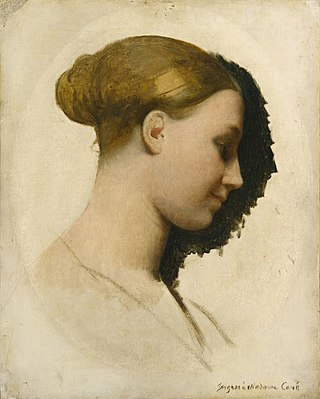
Madame Cavé was a French painter and drawing professor. Born Marie-Élisabeth Blavot and also known as Marie Monchablon in her youth, she married the painter Clément Boulanger and then, after Boulanger's death, Edmond Cavé—whom she also outlived.

The Murder of the Bishop of Liège is an oil painting on canvas created in 1829 by the French artist Eugène Delacroix, showing the murder of Louis de Bourbon, Bishop of Liège by William I de La Marck's men during the 15th-century Wars of Liège, as told in chapter 22 of Walter Scott's historical novel Quentin Durward. First exhibited at the Paris Salon of 1831, it is now in the Louvre in Paris.

Arab Horses Fighting in a Stable is an 1860 Orientalist painting by the French Romantic artist Eugène Delacroix, now in the musée d'Orsay.

Homage to Delacroix is an 1864 painting by Henri Fantin-Latour painted in homage to the French Romantic painter Eugène Delacroix who died the year before. The work features a group of painters and writers, all of whom went on to become notable themselves, gathered around a portrait of the late Delacroix. The painting was exhibited in the Paris Salon of 1864. Today the painting is part of the permanent collection of the Musee d'Orsay in Paris.
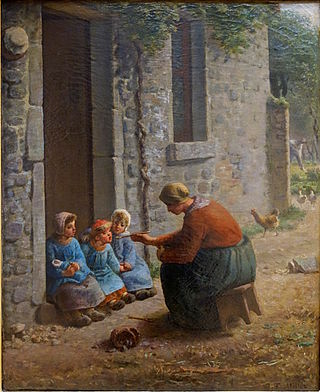
The Beakful, in French, La Becquée, or Woman Feeding Her Children is an oil-on-canvas painting by French artist Jean-François Millet, made in 1860. It is held at the Palais des Beaux-Arts de Lille.

The Winnower is the title of three oil on canvas paintings by French artist Jean-François Millet, created between 1847 and 1848. The first, now held at the National Gallery, in London, was painted in 1847-1848, and presented at the Salon of 1848. Subsequently, Millet created two other versions, one kept at the Louvre Museum, in Paris, much smaller than the original, and the other at the Musée d'Orsay, also in Paris.

The Corner of the Table is an oil-on-canvas painting by French artist Henri Fantin-Latour, created in 1872. It was exhibited at the 1872 Salon. It is held at the Musée d'Orsay, in Paris.

The Sigh of the Moor is an oil-on-canvas painting of Muhammad XII, (Boabdil), last Nasrid Emir of Granada. It was painted in the late 19th century by the Spanish artist Francisco Pradilla Ortiz. The painting depicts Boabdil, having ceded Granada to the Catholic Monarchs of Spain, Ferdinand and Isabella, turning to take a last look at the city he has lost, before going into exile.

Evening Prayer in the Sahara(French: Prière du soir dans le Sahara) is an 1863 painting by Gustave Guillaumet. Executed in oil on canvas and measuring 1.37m by 3.005m, it is one of the most celebrated desert paintings in the Musée d’Orsay. The painting is typical of Guillaumet’s earlier work, combining classical composition with a vast landscape populated by exotic figures, making it a standard orientalist genre scene.

Solitude is a painting by Thomas Alexander Harrison. It is oil on canvas, 100 cm x 170 cm. The painting was acquired by the French state from the Salon in 1893 and currently displayed at the Musée d'Orsay in Paris.
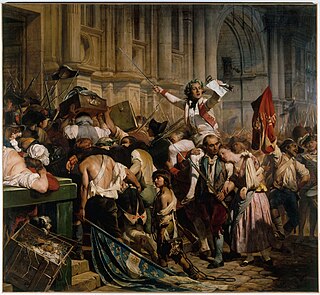
The Victors of the Bastille in Front of the Hôtel de Ville is a large oil on canvas painting by French painter Paul Delaroche, from c. 1835. it is held in the Petit Palais, in Paris.

Summary Execution under the Moorish Kings of Granada (French: Exécution sans jugement sous les rois maures de Grenade) is an oil on canvas painting by Henri Regnault. Completed in 1870, it was acquired by the state from Regnault’s heirs for display at the Musée du Luxembourg. It is currently in the collection of the Musée d'Orsay. A study for the figure of the executioner is also in the collections of the British Museum.
Remorse(French: Le Remords) is an oil on canvas painting by Louis-Marie Baader. It is a very large canvas, 376 cm high and 295 cm wide. It was first exhibited at the Salon of 1875 and was purchased by the state from the artist.

Arab Chiefs Challenging each other to Single Combat under the Ramparts of a City(French: Chefs de tribus arabes se défiant au combat singulier, sous les remparts d'une ville) is an oil painting on canvas executed in 1852 by the French painter Théodore Chassériau. It was one of three works by Chassériau accepted for the 1852 Salon. It is held at the Musée d'Orsay, in Paris.



















